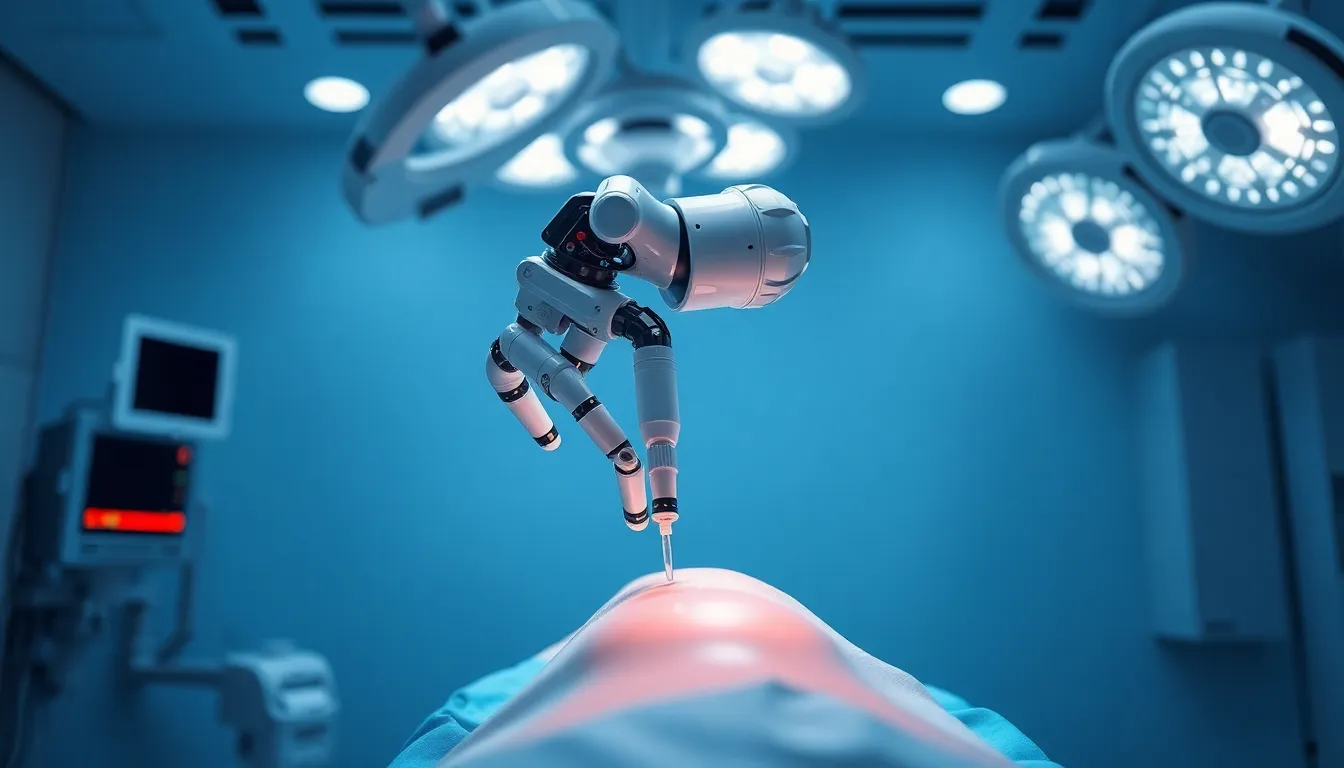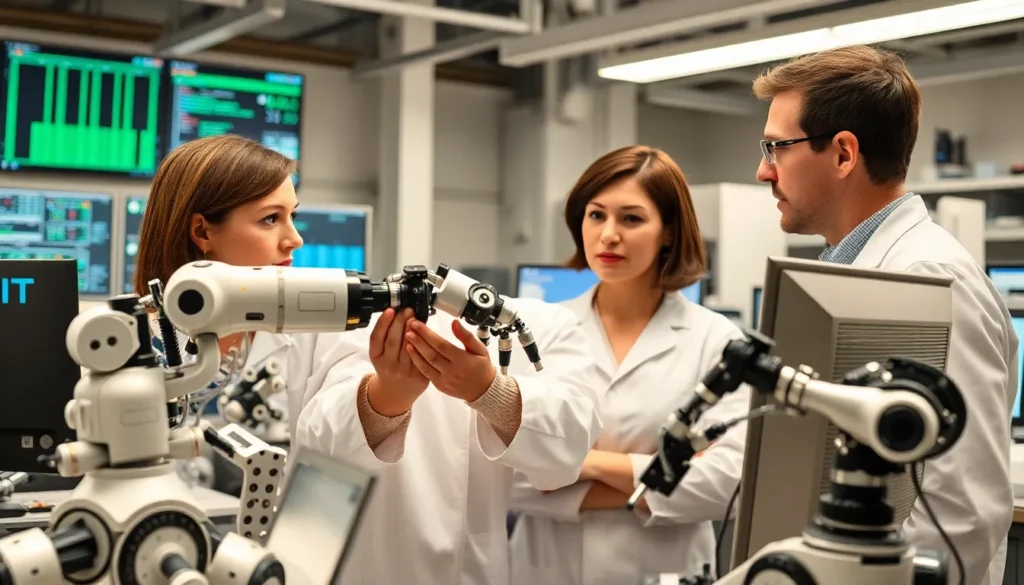Table of Contents
ToggleAt the intersection of innovation and imagination, MIT Robotics is where the magic happens. This powerhouse of technology isn’t just about building robots that can vacuum your living room—though that’s definitely a perk. It’s about pushing the boundaries of what machines can do, from navigating disaster zones to assisting in complex surgeries.
With a sprinkle of genius and a dash of quirky humor, researchers at MIT are crafting robots that not only work hard but also think smart. Imagine a robot that can crack a joke while calculating your next move in chess. It’s not just science fiction; it’s the reality at MIT. Dive into the world of robotics where creativity meets engineering, and discover how these brilliant minds are shaping the future—one robot at a time.
Overview of MIT Robotics
MIT Robotics stands at the forefront of technological innovation. Researchers engage in a variety of projects that push the boundaries of robotic capabilities. Their work transcends simple domestic applications; teams design robots for complex environments, including disaster response and surgical assistance.
Innovative designs feature robots that can adapt to unpredictable situations. These machines navigate challenging terrains and provide critical support during emergencies. In medical settings, robotic systems demonstrate precision, assisting surgeons during intricate procedures.
Collaboration between various departments fuels the creativity and engineering prowess evident in MIT Robotics. Artists, engineers, and computer scientists frequently join forces. This interdisciplinary approach enriches the development of robotics, leading to machines that not only perform tasks but also exhibit playful interactions.
Humor and creativity play significant roles in the designs of MIT robots. Researchers often incorporate lighthearted elements into their projects, making technology accessible and engaging. An example includes robots that can perform complex calculations while engaging in interactive games with users.
The vision of MIT Robotics combines imagination with practical application. This unique blend of artistic and scientific principles shapes the future of robotics. By continually pushing technological boundaries, MIT Robotics fosters an environment rich in discovery and innovation, setting a precedent for the entire field.
Key Research Areas

MIT Robotics emphasizes several key research areas that shape the future of robotics. These areas showcase innovations that address complex challenges across various sectors.
Autonomous Systems
Autonomous systems rank high among research priorities at MIT Robotics. These systems function without human intervention, utilizing advanced algorithms for navigation and decision-making. They excel in unpredictable environments such as disaster zones, where they assess situations and deliver aid effectively. Notable projects include drones and autonomous ground vehicles designed to support search and rescue missions. Researchers continually refine the capabilities of these autonomous systems, ensuring reliability and efficiency in critical situations.
Human-Robot Interaction
Human-robot interaction represents a dynamic aspect of MIT’s research efforts. This area focuses on developing robots that seamlessly collaborate with people in everyday tasks. These robots use advanced sensors and AI to interpret human cues, allowing for natural communication and cooperation. Projects encompass assistive robots that aid people with disabilities and playful robots intended for educational environments. Moreover, this research area addresses the emotional and social factors of robot design, enhancing user experience and engagement.
Robotics in Medicine
Robotics in medicine remains another crucial research area at MIT. Researchers develop sophisticated robotic systems aimed at improving surgical precision and patient care. Surgical robots enhance the capabilities of surgeons by providing advanced tools for minimally invasive procedures. Notable innovations include robotic arms that perform delicate tasks with high accuracy and telepresence robots that enable remote consultations. These advancements significantly impact patient outcomes while streamlining medical workflows. The collaboration between robotics expertise and medical knowledge drives these innovations forward.
Notable Projects and Initiatives
MIT Robotics showcases a range of projects that highlight its commitment to innovative technology. Researchers continually push boundaries to solve real-world challenges.
CSAIL Contributions
The Computer Science and Artificial Intelligence Laboratory, or CSAIL, plays a pivotal role in advancing robotics. Teams at CSAIL develop systems capable of complex navigation and decision-making. Their work on autonomous vehicles exemplifies cutting-edge research, improving safety and efficiency in transportation. Projects like robotic navigation in disaster scenarios demonstrate the importance of reliable algorithms for real-time problem-solving. Researchers emphasize collaboration, integrating insights from various fields to enhance functionality and adaptability in robotic designs.
MIT BioRobotics
MIT BioRobotics focuses on merging robotics with biological insights. Projects concentrate on developing robotic systems that enhance medical procedures. Surgical robots designed at MIT improve precision and safety during operations. These innovations include robotic arms that assist surgeons in minimally invasive techniques. Researchers also explore telepresence robots that enable remote healthcare consultations, broadening access to medical expertise. By prioritizing patient care, the BioRobotics initiative illustrates the potential for robots to transform healthcare landscapes.
Educational Opportunities in MIT Robotics
MIT Robotics offers a range of educational programs for aspiring engineers and researchers. These programs emphasize hands-on experience and interdisciplinary collaboration, equipping students with the skills needed to tackle complex challenges.
Undergraduate Programs
Undergraduate students explore robotics through the Department of Mechanical Engineering and the Electrical Engineering and Computer Science department. Programs integrate robotics into core curricula, enabling students to engage in projects that enhance creativity and technical skills. Students can participate in robotics competitions, such as the MIT Robotic Systems Challenge, which fosters teamwork and real-world problem-solving. Opportunities exist for internships at cutting-edge labs, allowing immediate application of theoretical knowledge.
Graduate Programs
Graduate programs at MIT Robotics attract students from diverse fields, fostering an environment of innovation and research. Master’s and PhD programs in robotics delve deeply into areas such as autonomous systems, human-robot interaction, and bio-robotics. Graduate students benefit from mentorship by leading researchers and access to state-of-the-art facilities. Collaborative projects with industry partners enhance career prospects, providing pathways that extend beyond traditional academia.
Industry Collaborations and Impact
MIT Robotics demonstrates significant industry collaborations that lead to groundbreaking innovations. Partnerships with leading companies and organizations provide vital resources and expertise. Contributing to fields like healthcare, automotive, and disaster response enhances the real-world applications of robotic technologies.
Robotics teams regularly engage with industries to identify pressing challenges and develop tailored solutions. These collaborations include projects focused on autonomous vehicles, where MIT greatly influences design through advanced algorithms. Efforts in healthcare show that machines can improve patient outcomes, particularly with robotic arms assisting in minimally invasive surgeries.
Research at the Computer Science and Artificial Intelligence Laboratory (CSAIL) emphasizes real-time navigation systems for disaster scenarios. Providing solutions in crisis situations showcases the agility of robots developed at MIT. Collaborative projects often involve artists, engineers, and technologists, resulting in user-friendly machines that address emotional and functional needs.
Partnerships expand beyond traditional sectors, reaching into environmental sustainability initiatives. For instance, robots designed for waste management streamline processes and support efforts toward a greener future. The influence of these collaborations resonates beyond academia, fueling ongoing advancements in technology.
Robotic competitions and shared initiatives encourage students to engage with industry partners actively. Events like the MIT Robotic Systems Challenge foster creativity and practical skills, ensuring that students contribute to future innovations. Graduates emerge equipped with hands-on experience, ready to tackle complex challenges in various fields.
Overall, the collaborative spirit at MIT Robotics propels innovations that address real-world problems. Developing machines that blend creativity with practical functions, MIT sets a new standard in robotic applications across industries. The continued partnership with various sectors solidifies MIT’s role as a leader in transforming the future of robotics.
MIT Robotics exemplifies the fusion of creativity and technology in the field of robotics. Its innovative projects not only address urgent real-world challenges but also enhance user interaction through playful designs. The collaboration among diverse disciplines fosters a rich environment for groundbreaking advancements.
As MIT continues to push the boundaries of robotics, its contributions in areas like autonomous systems and medical applications redefine what’s possible. The commitment to education and industry partnerships further solidifies its position as a leader in the robotics landscape. With a focus on solving complex problems, MIT Robotics is shaping the future of technology, paving the way for smarter and more adaptive machines.




